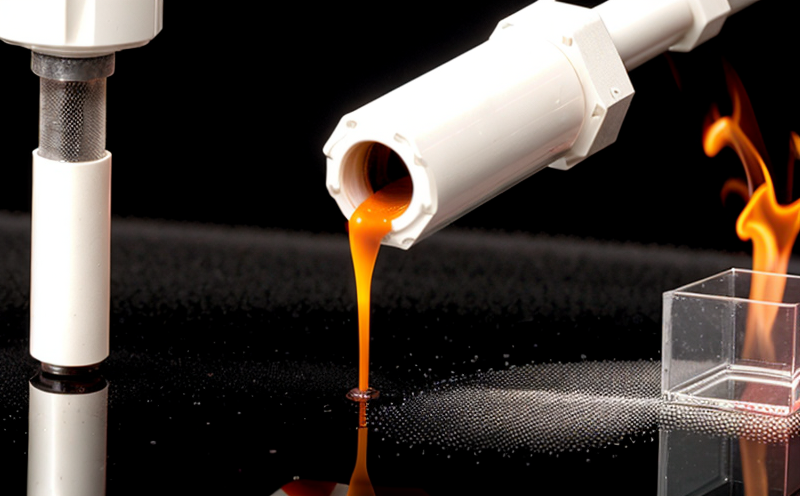ASTM D573 Thermal Aging of Nanostructured Elastomers
The ASTM D573 thermal aging test is a critical procedure used to assess the stability and degradation behavior of nanostructured elastomers under elevated temperatures. This test is particularly important in industries where materials must maintain their properties over extended periods without significant deterioration, such as automotive, aerospace, and medical device manufacturing.
ASTM D573 involves subjecting samples of nanostructured elastomers to controlled thermal environments for specified durations. The primary goal is to evaluate the long-term performance and durability of these materials under conditions that simulate real-world operational stresses. This method ensures compliance with international standards like ISO and ASTM, which are essential for ensuring product reliability and quality.
During this test, samples undergo exposure to high temperatures in an oven environment. The temperature can be adjusted according to the specific requirements of the sample or industry standards. After the specified duration, physical properties such as tensile strength, elongation at break, and hardness are measured to determine changes due to thermal aging.
Preparation for ASTM D573 testing involves careful selection and preparation of nanostructured elastomer samples. This includes ensuring uniformity in particle size distribution and dispersion within the polymer matrix. Proper sample preparation is crucial as it affects the accuracy of the test results. It also ensures that any observed changes are attributable to the thermal aging process rather than variations in sample composition.
The ASTM D573 method provides a standardized approach for evaluating how nanostructured elastomers respond to extreme temperature conditions. This information is invaluable for researchers and engineers developing new materials or optimizing existing ones. By understanding how these materials behave under thermal stress, they can make informed decisions about material selection and design optimization.
Understanding the nuances of ASTM D573 testing allows us to appreciate its importance in ensuring product longevity and performance reliability across various industries. This test plays a pivotal role in meeting regulatory requirements while also contributing significantly to research advancements within the field.
| Industry | Description |
|---|---|
| Aerospace | Evaluating materials that will be exposed to high temperatures during flight operations. |
| Military | Determining the suitability of materials for use in harsh environmental conditions. |
| Automotive | Assessing components designed to withstand engine heat and exhaust systems. |
| Sample Type | Description |
|---|---|
| Polymer Nanocomposites | Mixtures containing nanoparticles within a polymer matrix. |
| Bio-Compatible Materials | Elastomers used in medical devices where biocompatibility is crucial. |
| Sporting Goods | Materials for components that require durability and flexibility under stress. |
Industry Applications
The ASTM D573 thermal aging test finds extensive application across numerous sectors, including automotive, aerospace, medical device manufacturing, sports goods production, and defense. Each of these industries has unique requirements regarding material performance under extreme temperature conditions.
In the automotive industry, this test helps ensure that components like seals and hoses can maintain their integrity during engine operation.
Aerospace applications require materials capable of withstanding intense heat from jet engines or space environments. Testing ensures reliability in critical parts.
The medical device sector benefits by verifying the stability of bio-compatible elastomers used in implants and other life-saving devices.
Sports equipment manufacturers use this test to develop durable, flexible materials for products like running shoes or bicycle tires.
These examples illustrate just how versatile and essential ASTM D573 thermal aging testing is across diverse industries. By providing consistent results, it supports innovation while ensuring safety standards are met.
Why Choose This Test
Selecting the appropriate method for evaluating nanostructured elastomers is crucial for obtaining reliable data on material performance. ASTM D573 offers several advantages over other testing methods:
It provides a standardized approach, ensuring consistent results across different labs.
The test allows for controlled environmental conditions, allowing researchers to replicate real-world scenarios accurately.
Data obtained from ASTM D573 can be used to predict long-term material behavior, aiding in product development and quality assurance processes.
By choosing ASTM D573 thermal aging testing, you ensure that your materials meet stringent industry standards. This not only enhances the reputation of your products but also contributes to safer, more reliable applications.
Quality and Reliability Assurance
Consistent adherence to ASTM D573 ensures accurate measurement and comparison of material properties before and after thermal aging.
This method helps in identifying potential issues early in the development process, allowing for necessary adjustments before mass production begins.
The test results contribute significantly to improving product quality through better understanding of materials' limitations and capabilities.
Implementing ASTM D573 thermal aging testing as part of your quality assurance protocols demonstrates commitment to maintaining high standards. It provides valuable insights into material behavior under stress, ensuring that only reliable products reach the market.





